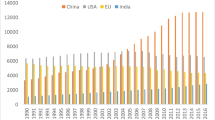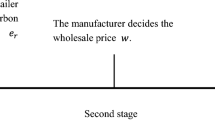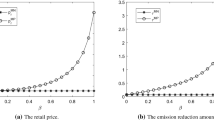Abstract
This paper explores the impact of carbon cap-and-trade policies and consumer low-carbon preferences on the choice of manufacturers’ product lines. We further investigate the optimal decisions of manufacturers under different product line strategies. Moreover, we analyze consumer surplus, environmental impact, and social welfare under different product line strategies. The results show that producing low-carbon and ordinary products is the optimal product line strategy for manufacturers. In addition, we demonstrate that when considering carbon cap-and-trade policies and consumers' low-carbon preferences, the consumer surplus, environmental impact, and social welfare when manufacturers produce low-carbon products are always better than in other scenarios. Furthermore, our research results also show that with the increase of carbon trading prices, the consumer surplus and social welfare when manufacturers choose to produce low-carbon products are always better than in other scenarios. However, we find that the environmental impact is not always outperforming when manufacturers choose a product line that produces low-carbon products than other scenarios.










Similar content being viewed by others
Data availability
Data sharing is not applicable to this article as no datasets were generated during the current study.
References
Basiri Z, Heydari J (2017) A mathematical model for green supply chain coordination with substitutable products. J Clean Prod 145:232–249
Bechler G, Steinhardt C, Mackert J, Klein R (2021) Product line optimization in the presence of preferences for compromise alternatives. Eur J Oper Res 288(3):902–917
Cai W, Chen YJ (2017) Channel management and product design with consumers probabilistic choices. Int J Prod Res 55(3):904–923
Cao E, Yu M (2019) The bright side of carbon emission permits on supply chain financing and performance. Omega 88:24–39
Chen YJ, Tomlin B, Wang Y (2013) Coproduct technologies: product line design and process innovation. Manage Sci 59(12):2772–2789
De M, Giri BC (2020) Modelling a closed-loop supply chain with a heterogeneous fleet under carbon emission reduction policy. Transport Res Part E: logistics Transport Rev 133:101813
Dong LX, Guo XM, Turcic D (2019) Selling a product line through a retailer when demand is stochastic: analysis of price-only contracts. Manuf Serv Oper Manag 21(4):742–760
Dou GW, Choi TM (2021) Does implementing trade-in and green technology together benefit the environment? Eur J Oper Res 295(2):517–533
Du SF, Zhu JA, Jiao HF, Ye WY (2015) Game-theoretical analysis for supply chain with consumer preference to low carbon. Int J Prod Res 53(12):3753–3768
Du S, Hu L, Wang L (2017) Low-carbon supply policies and supply chain performance with carbon concerned demand. Ann Oper Res 255:569–590
Feng H, Zeng Y, Cai X, Qian Q, Zhou Y (2021) Altruistic profit allocation rules for joint replenishment with carbon cap-and-trade policy. Eur J Oper Res 290(3):956–967
Ghosh SK, Seikh MR, Chakrabortty M (2020) Analyzing a stochastic dual-channel supply chain under consumers’ low carbon preferences and cap-and-trade regulation. Comput Industr Eng 149:106765
Guo J, Huang R (2021) A carbon tax or a subsidy? Policy choice when a green firm competes with a high carbon emitter. Environ Sci Pollut Res. https://doi.org/10.1007/s11356-020-12324-4
Guo L, Zhang JJ (2012) Consumer deliberation and product line design. Mark Sci 31(6):995–1007
Haehl C, Spinler S (2020) Technology choice under emission regulation uncertainty in international container shipping. Eur J Oper Res 284(1):383–396
He P, He Y, Shi CV, Xu H, Zhou L (2020) Cost-sharing contract design in a low-carbon service supply chain. Comput Indus Eng 139:106160
Hsiao L, Chen YJ, Xiong H (2019) Supply chain coordination with product line design and a revenue sharing scheme. Nav Res Logist 66(3):213–229
Hong ZF, Wang H, Yu YG (2018) Green product pricing with non-green product reference. Transport Res E logist Transport Rev 115:1–15
Hong ZF, Wang H, & Gong YM (2019) Green product design considering functional-product reference. Int J Prod Econ 210: 155–168.
Jerath K, Kim SH, Swinney R (2017) Product quality in a distribution channel with inventory risk. Mark Sci 36(5):747–761
Ji JN, Zhang ZY, Yang L (2017) Carbon emission reduction decisions in the retail-/dual-channel supply chain with consumers’ preference. J Clean Prod 141:852–867
Jian M, He H, Ma C, Wu Y, Yang H (2019) Reducing greenhouse gas emissions: a duopoly market pricing competition and cooperation under the carbon emissions cap. Environ Sci Pollut Res 26:16847–16854
Kuiti MR, Ghosh D, Basu P, Bisi A (2020) Do cap-and-trade policies drive environmental and social goals in supply chains: Strategic decisions, collaboration, and contract choices. Int J Prod Econ 223:107537
Krass D, Nedorezov T, & Ovchinnikov A (2013). Environmental taxes and the choice of green technology. Prod Oper Manag 22 (5): 1035-1055.
Lampert P, Menrad K, Emberger-Klein A (2017) Carbon information on vegetables: How does it affect the buying process? Int J Consum Stud 41:618–626
Li G, Zheng H, Ji X, Li H (2018) Game theoretical analysis of firms’ operational low-carbon strategy under various cap-and-trade mechanisms. J Clean Prod 197:124–133
Li H, Webster S, Yu G (2020) Product design under multinomial logit choices: Optimization of quality and prices in an evolving product line. Manuf Serv Oper Manag 22:1011–1025
Luo Z, Chen X, Wang XJ (2016) The role of co-opetition in low carbon manufacturing. Eur J Oper Res 253(2):392–403
Ma SG, He Y, Gu R, Li SS (2021) Sustainable supply chain management considering technology investments and government intervention. Transport Res E Logist Transport Rev 149:102290. https://doi.org/10.1016/j.tre.2021.102290
Mirzaee Ghazani M, Jafari MA (2021) The efficiency of CO2 market in the phase III EU ETS: analyzing in the context of a dynamic approach. Environ Sci Pollut Res. https://doi.org/10.1007/s11356-021-15044-5
Moon I, Park KS, Hao J, Kim D (2017) Joint decisions on product line selection, purchasing, and pricing. Eur J Oper Res 262(1):207–216
Peng Q, Wang C, Xu L (2020) Emission abatement and procurement strategies in a low-carbon supply chain with option contracts under stochastic demand. Comp Indus Eng 144:106502
Raz G, Druehl CT, Blass V (2013) Design for the environment: life-cycle approach using a newsvendor model. Prod Oper Manag 22(4):940–957
Rong Y, Chen YJ, Shen ZJ (2015) The impact of demand uncertainty on product line design under endogenous substitution. Nav Res Logist 62(2):143–157
Shen B, Cao YF, Xu XY (2020) Product line design and quality differentiation for green and non-green products in a supply chain. Int J Prod Res 58(1):148–164
Wong H, Kim K, Chhajed D (2021) Reducing channel inefficiency in product line design. Int J Prod Econ. https://doi.org/10.1016/j.ijpe.2020.107964
Wu P, Jin Y, Shi YJ, Shyu H (2017) The impact of carbon emission costs on manufacturers’ production and location decision. Int J Prod Econ 193:193–206
Xiong H, Chen YJ (2013) Product line design with deliberation costs: a two-stage process. Decis Anal 10(3):225–244
Xu Z, Dukes AJ (2019) Product line design under preference uncertainty using aggregate consumer data. Mark Sci 38:669–689
Xu XP, He P, Xu H, Zhang QP (2017a) Supply chain coordination with green technology under cap-and-trade regulation. Int J Prod Econ 183:433–442
Xu XP, Zhang W, He P, Xu XY (2017b) Production and pricing problems in make-to-order supply chain with cap-and-trade regulation. Omega 66:248–257
Yang L, Hu Y, Huang L (2020) Collecting mode selection in a remanufacturing supply chain under cap-and-trade regulation. Eur J Oper Res 287(2):480–496
Yenipazarli A (2019) Incentives for environmental research and development: Consumer preferences, competitive pressure and emissions taxation. Eur J Oper Res 276:757–769
Yu J (2021) A model of brand architecture choice: a house of brands vs. A branded house. Market Sci 40:147–167
Yu M, Cruz JM, Li D, Masoumi AH (2021) A multiperiod competitive supply chain framework with environmental policies and investments in sustainable operations. Eur J Oper Res. https://doi.org/10.1016/j.ejor.2021.07.028
Zhang J, Huang J (2021) Vehicle product-line strategy under government subsidy programs for electric/hybrid vehicles. Transport Res E Logis Transport Rev 146:102221. https://doi.org/10.1016/j.tre.2020.102221
Zhang L, Wang J, You J (2015) Consumer environmental awareness and channel coordination with two substitutable products. Eur J Oper Res 241(1):63–73
Zhao R, Zhou XJ, Han J, Liu C (2016) For the sustainable performance of the carbon reduction labeling policies under an evolutionary game simulation. Technol Forecast Soc Chang 112:262–274
Zou T, Zhou B, Jiang B (2020) Product-line design in the presence of consumers’ anticipated regret. Manage Sci 66:5665–5682
Author information
Authors and Affiliations
Contributions
Hua Wang: conceptualization, methodology, software, formal analysis, investigation, writing—original draft. Lan Wang: supervision, conceptualization, methodology, validation, resources—review and editing. Qiyan Ding: conceptualization, methodology, funding acquisition, validation, writing—review and editing. All authors read and approved the final manuscript.
Corresponding author
Ethics declarations
Ethics approval and consent to participate.
Not applicable.
Consent for publication.
Not applicable.
Conflict of interest
The authors declare no competing interests.
Additional information
Communicated by Philippe Garrigues.
Publisher's Note
Springer Nature remains neutral with regard to jurisdictional claims in published maps and institutional affiliations.
Rights and permissions
About this article
Cite this article
Wang, H., Wang, L. & Ding, Q. Manufacturers’ product line strategies and environmental impacts under carbon cap and trade policies. Environ Sci Pollut Res 29, 40781–40795 (2022). https://doi.org/10.1007/s11356-021-17909-1
Received:
Accepted:
Published:
Issue Date:
DOI: https://doi.org/10.1007/s11356-021-17909-1




